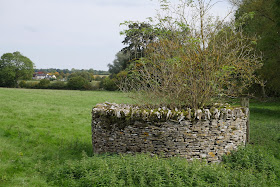The prettiest house in Stonesfield
We spotted this walk in the Ramblers magazine and it felt just right for an interesting Sunday stroll. We started out from the White Horse pub on the north side of the village and skirted its edge to turn right onto the Oxfordshire Way (we walked this section in the opposite direction when we were doing the Oxfordshire Way a few years ago).
We headed across open country and turned left towards the hamlet of Fawler, where we passed the substantial Fawler Manor (1660).
We walked under a railway bridge and crossed the River Evenlode by a small bridge
Now we followed a bottom-of-the valley track which led into Finstock. On the right a large flowering ivy was home to a good number of Red Admiral ...
.. and Comma butterflies. What a delight!
We turned left by the Plough Inn and headed uphill and then across fields to another hamlet, Wilcote. We made a small detour to see the 12th century church of St Peter. Pevsner is rather scathing, calling it "bleak and drab". That is perhaps a bit harsh - it is quite picturesque.
Perhaps his real point is that one blocked doorway is the only evidence of its Norman origins, the church having been restored twice in the 19th century, including the addition of the porch.
We skirted Wilcote Grange and headed downhill entering a pleasing avenue of trees on the right side.
At the bottom of the slope is the remains of the Lady Well.
Soon after this we passed the handsome Bridewell Farm. The stone over the doorway seems to promise a date, but I cannot decipher it.
A short stretch of road and some field paths brought us to the village of East End. We turned right, through, woodland and successfully navigated our way to the correct exit, near the Stonesfield Roman Villa. Pevsner describes it as "small", but there is quite a large footprint of one-time walls.
One of the information boards has a reconstruction, which suggests a quite substantial building.
Under cover in locked building there is the remains of a mosaic, illustrated on another panel.
We headed northwards up an extremely sunken path which led to the edge of the pretty stone village of Stonefield.
Conditions: greyish, but mild.
Distance: 8 miles.
Map: Explorer 180 (Oxford, Witney & Woodstock).
Rating: four stars. Most enjoyable.






















































